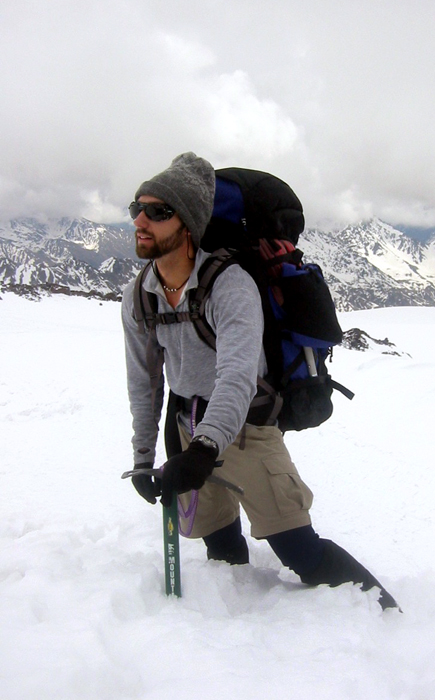|
New horizonsPaul Queior detours from Seven Summits bid for stint at Palmer StationPosted August 29, 2008
Most people will tell you that they joined the U.S. Antarctic Program A network engineer at Palmer Station He gave up a full-time job with Raytheon Company, the parent company for Raytheon Polar Services, the prime contractor for the USAP, for the opportunity to see another corner of the world. “I was ready to move and come down to the Ice,” Queior said, after living three years in San Diego, Calif., working for Raytheon’s Integrated Defense Systems. “The whole Antarctic contract gig combines a couple of things I’m passionate about — the environment, outdoors, unusual settings,” he explained by phone from Palmer, which is currently home to 34 support staff and scientists. “It’s like this crazy setting, but it still lets me be an info tech geek, which scratches another itch for me.” Indeed, it’s thanks to people like Queior and others in the USAP geek squad that allows someone from the Denver office to call the Ice on his cell phone, dialing as many digits as one would to order a pizza or call a friend across town. The satellite-based system can be a little slow — some latency issues, in IT speak — but it works well. “It’s a pretty good infrastructure the USAP has down here. I was impressed,” Queior said. “It’s surprising how normal [the job] is until you look out your window.” Queior has enjoyed some pretty good views in his 29 years. He and his good buddies are in the midst of a quest to climb the so-called Seven Summits, the highest peaks on the world’s seven continents. Since 2002, he and his team have topped out on Mount Kilimanjaro in Tanzania, Mount Elbrus in Russia, Cerro Aconcagua in the Argentinean Andes, and Mount McKinley, or Denali, in Alaska. That leaves the three toughest mountains on the list: Puncak Jaya in Indonesia, Vinson Massif in Antarctica and, of course, the grand daddy of mountains, Mount Everest. (Some mountaineers include Australia’s Mount Kosciuszko on their Seven Summit lists, though the 2,228-meter-tall mountain is more of an afternoon hike for most.) Queior grew up in southern Maine enjoying the outdoors camping, canoeing and hiking. In college, at Brandeis University “I started to stay out longer and go higher,” he said. The Seven Summits bid just sort of happened, he explained, when Queior connected with his (now) close friend Matthew Hurley at his first job out of college. “We said, ‘Hey, let’s go climb Kilimanjaro.’ Why not? I think everyone should climb Kilimanjaro,” he added, with a laugh. “We wanted to see these continents, anyway, so it seemed like as good a way as any to get there.” Queior conceded that the last three will be hard to bag, particularly Vinson and Everest, which require loads of cash as well as a lot of moxie. It costs tens of thousands of dollars to hire an expedition outfit to drag you up Mount Everest. “That’s not really the style we’ve been [doing]. We’re much more into the whole experience, planning our own trip and finding our own routes.” Queior’s own route has taken him to the bottom of the world, a sort of crossroads for fellow travelers — certainly a change from the water-cooler circles of the 9-to-5 corporate lifestyle. “The contract lifestyle is quite appealing to me right now,” Queior said. “On top of the fact that everyone here is just really cool, really high quality, really diverse, interesting people who have been all over the world. “I went to the little hidden pocket of Raytheon, where every single person has been all over the world and has these outrageous stories to tell,” he added. At Palmer, Queior has taken the lead on the station’s Glacier Search and Rescue team. He’s also settled into the rhythm of life on the small science outpost, taking lunch break hikes up the nearby glacier, playing the popular board and card games of the season, and generally connecting with people. “It’s quite a rewarding place and lifestyle,” he said. Still, there are daydreams of the next adventure. Perhaps a bid for the summit of Puncak Jaya, with a quick run up Mount Kosciuszko while in that part of the world. Or there’s his 36-foot sloop in San Diego harbor that he’s called home for three years. “I miss my sailboat, and I’m looking forward to possibly pursuing some segment of another little fantasy, which is circumnavigation by sail,” he said. “I’ve read lots of books, and it’s fanciful and romantic and exciting, and something I’m sure I would never look back on and regret the time.” There’s much on Paul Queior’s horizon, including a possible return to the Ice someday. “Perhaps this change to contract, Antarctic work, is an indication that I’m not quite ready for 9-to-5, five-day-a-week job,” he said.
|



For USAP Participants |
For The Public |
For Researchers and EducatorsContact UsU.S. National Science FoundationOffice of Polar Programs Geosciences Directorate 2415 Eisenhower Avenue, Suite W7100 Alexandria, VA 22314 Sign up for the NSF Office of Polar Programs newsletter and events. Feedback Form |



